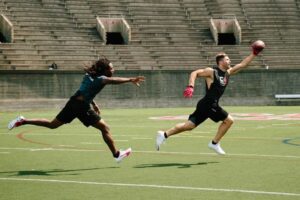While studying Iyengar Yoga in Spain, we would practice holding our body in correct alignment, to train ourselves how to stand in the best way possible. We would pull the shoulder blades back and down, engage our core muscles, pull the knee caps up, all of this strengthening the muscles that prevented poor/weak posture. We were, in essence, “correctly” aligning our skeleton with our muscles. We would stand there in Tadasana and breathe, engaging the “important” muscles in this posture for minutes.
One purpose of learning how to stand was to improve our posture, strength and balance in general. But if I’m honest with myself, and if ‘m really honest with you the reader, my posture did not improve while I practiced yoga in Spain. I don’t know if my strength and balance improved either – there wasn’t enough of a difference for me to notice.
Probably just like me, you learned how to “stand up straight,” maybe in something other than yoga like gym class or by other people in your life. We were taught to do this, this, and this with our body to learn good posture. This begs the question though: Do I really need to teach my body how to stand up? I didn’t need to teach my body how to beat my heart or digest my food or breathe.
Then why was I spending so much effort on contorting my body to “teach” or “maintain” it to stand up in the best way?
The short answer is: You can bypass all of this.
Engaging the core, tucking the pelvis, engaging the legs, this is what I did before I learned more about anatomy, physiology and posture dynamics, particularly what’s known as the Postural Mechanism.
Your body has been taking care of effortless posture, balance and strength ever since you were born…literally. The first time your spine curves into its tertiary curve (your neck) is when you exit through the birth canal of your mother! From that day on, your postural mechanism has been taking in and playing with information, like the physical forces at play that Isaac Newton explained – the earth supporting you up and gravity rooting you down.
So, while standing up, also known as Tadasana, the simplest way to sustain easeful posture is to stop interfering with your postural mechanism. Human muscles work in agonist-antagonist harmony with each other – in order to bend your elbow the biceps must contract and the triceps must release. Furthermore, if you are consciously contracting your abdominis rectus muscles, you are forcing your deeper core muscles (known as your postural muscles) to disengage, in effect destabilizing you! If you have a chance to observe young children, they have effortless posture, and they didn’t have to remember how to hold or engage themselves in an unnatural way.
The more “corrections” I un-learn in my body, such as pulling the navel toward the spine, and the more postural habits I become aware of and then un-do, such as subconsciously pulling the head back and up, the stronger and more expanded I stand and move from. I no longer think I know better than my own body’s postural mechanism, which is mostly subconscious activity like the beating of your heart, nor feel the need to interfere with it.
The next time you’re practicing Tadasana in the way you normally do, notice how much time goes by until you start to feel discomfort in any way in your body. Then I invite you to try not engaging in any “engaging,” that is any corrections/adjustments you usually practice (known as inhibition in Alexander Technique). The point is to un-do, not add on. Let your postural mechanism do its job because it can do it better than you can try to do it with your mind-body control.
How useful was this post?
Click on a star to rate it!
Average rating 0 / 5. Vote count: 0
No votes so far! Be the first to rate this post.




